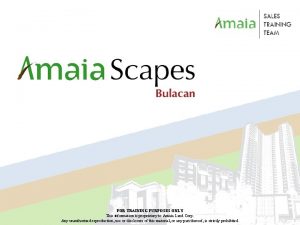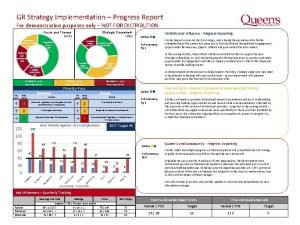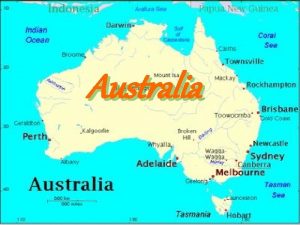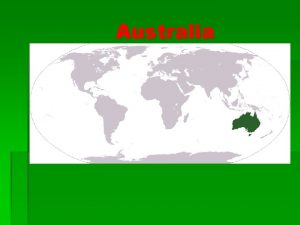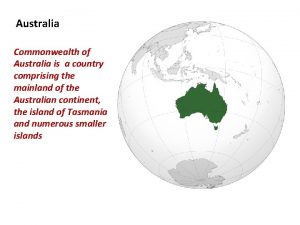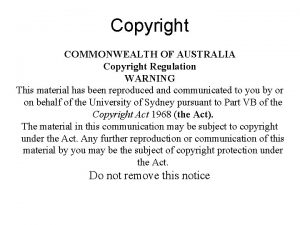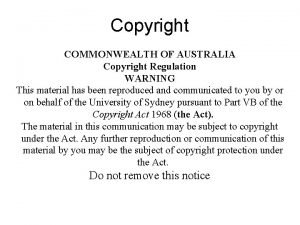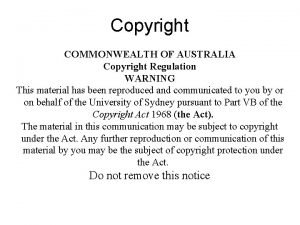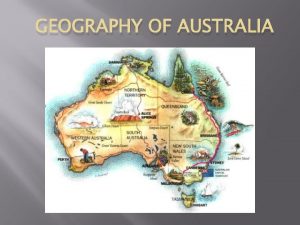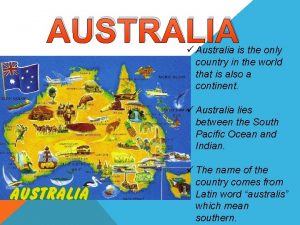For Education Purposes Only COMMONWEALTH OF AUSTRALIA Copyright




















































- Slides: 52

For Education Purposes Only COMMONWEALTH OF AUSTRALIA Copyright Regulations 1969 WARNING This material has been reproduced and communicated to you by or on behalf of Queensland University of Technology pursuant to Part VB of the Copyright Act 1968 (the Act). The material in this communication may be subject to copyright under the Act. Any further reproduction or communication of this material by you may be the subject of copyright protection under the Act. Do not remove this notice. CRICOS No. 00213 J

SAMFORD VALLEY and its Physical Features Samford Valley Natural Systems Framework School of Natural Resource Sciences QUT CRICOS No. 00213 J

The Samford Valley is a well-defined physical feature surrounded by ranges on the west and open to the coastal plain to the northeast. QUT has a specific interest in the valley due to the recent acquisition of the property, The Barracks, from the Dr “Pat” Marks estate. This property is in the southeast of the valley, and will be used for educational purposes. The valley as a whole, however, has been of long term interest to geologists and geomorphologists due to its unique formation, by emplacement and weathering of a granitic intrusion. The valley also has interesting features in regard to its drainage systems and groundwater occurrence. The Samford Valley is also a good example of a “peri-urban” setting and is at the boundary between rural and residential. The valley retains some rural properties, has residential areas, and m a n y n e w e r r u r a l - r e s i d e n t i a l p r o p e r t i e s. There is a strong sense of community in the valley, and a high level of interest in its history. These web pages have been produced to provide an overview to the physical setting of the valley, and some explanation of its geological history and natural systems. CRICOS No. 00213 J

Samford Valley CRICOS No. 00213 J Thematic Mapper satellite image, Geoimage

Physiographic subregions: Samford Valley is within the highlands, and open Subcoastal highlands Plateaus Coastal lowlands Subcoastal lowlands CRICOS No. 00213 J Samford Valley

Samford Valley within the D’Aguillar Ranges only 20 km to the northwest of Brisbane City. The image shows the residential development on the coastal plain and along the Brisbane River. CRICOS No. 00213 J Image from Microsoft Local Live

Simplified geology of the Brisbane region. This map shows that the Samford Valley is one of four intrusions of granitic rock into the older “basement” country rocks < 100, 000 40 – 45 my 100 -150 my ~220 my ~250 my 350 – 425 my Ages of Rocks CRICOS No. 00213 J From: Willmott and Stevens 1992

Geomorphology CRICOS No. 00213 J

The well defined geomorphological features of Samford Valley can be seen in this oblique image taken from Google Earth. This view is towards the northwest. The valley is a good example of differential weathering (“reverse weathering”) where the granitic pluton itself has weathered away more than the country rocks. The South Pine River flows out to the right (northeast). CRICOS No. 00213 J

Samford Topographic map: this older map shows topography by contour lines at 20 m intervals. ap scale is 1: 50, 000 and the grid squares are 1, 000 m. The valley floor is 60 -80 m ASL, and surroundin ranges are over 400 m higher. Mt Nebo is around 450 m ASL; Jolly’s Lookout is 512 m ASL. CRICOS No. 00213 J Royal Australian Survey Corps, 1974

Samford Valley aerial photo compilation CRICOS No. 00213 J Aerial flown March, 2002 CRICOS photography No. 00213 J Department Natural Resources & Water, 2

Elevation is presented as a 10 -m digital elevation model (DEM), based on 1 -m contours. Elevation ranges between 30 and 630 m ASL, with a break in slope at around 150 -200 m (dark green on the map) CRICOS No. 00213 J

Another DEM (digital elevation model) using a gray tone which clearly shows the valley morphology This image also has the drainage system included. The DEM data at 1 m spacing was provided by Pine Rivers Shire. CRICOS No. 00213 J Km

Here the digital geology data (Geological Survey of Queensland) has been overlain on the DEM image, and the drainage systems added. Note the volcanic rocks (andesite) at Jolly’s Lookout. CRICOS No. 00213 J

This map displays the variation of slope (as %) within the valley and its sides. Slope ranges from flat (0%) to well over 50%. The valley floor is generally flat to less than 10% slope. lley floor is mostly 60 -80 m ASL, and the surrounding ranges rise to over 400 m ASL with very steep s CRICOS No. 00213 J

Aspect refers to the orientation of a slope (direction it faces). Colours such as red, purple, orange and yellow depict ‘warm’ orientations towards N, NW, W, NE and E. Shades of blue highlight ‘cooler’ south-facing orientations. Grey is associated with flat terrain, generally slopes less than 5%, which is much of the valley floor. CRICOS No. 00213 J

Geology CRICOS No. 00213 J

Geological History <1. 8 Ma: Quaternary coastal deposits 25 -26 Ma: rhyolitic volcanic plus of Glass Houses (& basaltic volcanism at Mt Glorious) . 40 -45 Ma: basaltic volcanism Redlands/Redcliffe ~210 -150 Ma: sediments deposited in Nambour Basin (late Triassic – Jurassic) 220 Ma: continuing erosion ~220 Ma: magma emplaced as granitic plutons 290 -220 Ma: more sediments deposited, and volcanism (e. g. Jolly’s Lookout Andesite) CRICOS No. 00213 J 320 -290 Ma: major compression and folding Map: Department of Mines and Energy with uplift of metamorphic rocks

The Samford Granodiorite (a granitic rock) has weathered out forming the valley CRICOS No. 00213 J

Samford Granodiorite is eroded by differential weathering to form the current valley CRICOS No. 00213 J

Climate and rainfall CRICOS No. 00213 J

Orographic effect of rainfa Samford Valley Prevailing SE winds CRICOS No. 00213 J

Samford Valley Rainfall of the local region CRICOS No. 00213 J

A boundary of the Samford Valley can be delineated based on the geology. Annual average rainfall values from 14 weather stations within a neighbourhood of 600 km 2 were interpolated, with a zoomed-in view of the rainfall distribution within the valley. Orographic effect is apparently a significant factor controlling rainfall distribution on the local as well as regional scale. The relief has resulted in over 800 mm more rainfall at the station 40308 (at Mount Glorious with an elevation of 603 m) than at the station 40041 (within the valley with an elevation of 69 m). A linear relationship between the elevation and rainfall can be expressed as: y = 0. 7302 x + 1074. 6 where x is the elevation and y denotes the annual average rainfall. The associated R-square value is 0. 6284. The effective uniform depth (EUD) of precipitation for the Samford Valley; this is mean value of rainfall over the spatial coverage of the valley, is calculated to be 1016. 6 CRICOS No. 00213 J

Topography and isohyets (contours of average rainfall in mm per year). Note the rainfall gradient from ~1000 on the coastal plain to > 1400 mm on the ranges CRICOS No. 00213 J 0 1 2 3 4 5 Kilometres

Mean annual rainfall compared to temperature. These data are the monthly average at the Samford CSIRO site (1912 -2003). The lower rainfall in winter, and the higher rainfall in late summer can be seen. These are typical of sub-tropical settings. CRICOS No. 00213 J

The Samford Valley has a subtropical climate, which is typical of SE Queensland. Auliciems (1990) notes that “during high-sun periods (November to April) moist, unstable, subtropical maritime air flows in from the Pacific. Surface air is warm and marked instability characterises the pressure field which leads to strong vertical motion of the lower layers of the atmosphere to induce condensation – heavy rainfall and thunderstorm result. During the low-sun period (May to October) the large scale air flow is from the southwest – this continental air is mainly dry and stable. ” The figure 1 illustrates the mean monthly rainfall at Samford and highlights the dominance of summer rainfall. Auliciems, A. , 1990. Climates of the Brisbane Valley. In: P. Davie, E. Stock and D. L. Choy (Editors), The Brisbane River: a source-book for the future. The Australian Littoral Society Inc. , Moorooka, pp. 7 -16. Bureau of Meteorology, 2006. Climate Averages for Australian Sites Averages for SAMFORD CSIRO. Commonwealth of Australia, http: //www. bom. gov. au/climate/averages/tables/cw_040241. shtml. CRICOS No. 00213 J

mean rainfall (Mt Nebo Post Office) over a 40 year period, which have been averaged over shorter per (top) 5 years, and (bottom) 8 years. These “moving averages” can indicate longer term trends, which here is of decreasing rainfall over this period. CRICOS No. 00213 J

Drainage system CRICOS No. 00213 J

Drainage system and isohyets (mm rainfall) CRICOS No. 00213 J 0 1 2 3 4 5 Kilometres

Geology and drainage system CRICOS No. 00213 J

Topography, drainage system, localities and main roads CRICOS No. 00213 J

Stream Hydrograph A stream hydrograph typically shows the fluctuations in stream flow through time. For the Samfor the stream flow of the South Pine River was routinely measured since 1965. Daily records are available from the DNR&M. The next figure depicts the daily rainfall and stream flow during the year of 2000. Increases in the stream flow correspond to rainfall events. The figure shows, (a) the relationship between rainfall and stream flow at the South Pine River in and (b) the output of baseflow separation. The stream hydrograph is separated into two compone direct runoff and baseflow. For a gaining stream, where groundwater is contributing to stream flow, analysis of the stream hy can indicate the magnitude and timing of this contribution, gain insights into the relationships betw and aquifers and thereby support the management of water resources. Kosseris, W. C. , 1997. Estimation of Natural Groundwater Recharge by Baseflow Recession Anal Samford Valley, Queensland. Graduate Diploma in Applied Science Research Report Thesis, Queensland University of Technology, Brisbane. Nathan, R. J. and Mc. Mahan, T. A. , 1990. Evaluation of automated techniques for baseflow and recession analysis. Water Resources Research, 26: 1465 -1473. CRICOS No. 00213 J

CRICOS No. 00213 J

The stream hydrographs for the years 1966 -2005 were examined. A recursive digital filter was used to separate the baseflow component of these hydrographs. The filter applied was that used by Nathan and Mc. Mahon (1990) with a consistent filter parameter set as 0. 925. Annual baseflow indices (BFI) were calculated. The mean value of BFI for the 40 -year period is 0. 342 and the standard deviation is 0. 1, indicating a consistent contribution of baseflow to the river. The year of 2000 was identified as an outlier, with a BFI of 0. 711. This high value was inferred to be due to water use or management activities such as stream or groundwater exaction. Nathan, R. J. and Mc. Mahan, T. A. , 1990. Evaluation of automated techniques for baseflow and recession analysis. Water Resources Research, 26: 1465 -1473. CRICOS No. 00213 J

These two figures show hydrographs for the Drapers Crossing gauging station of the S for the years 1966, 1976, 1986, 1996 and 2005. CRICOS No. 00213 J

CRICOS No. 00213 J

Landuse and water supply CRICOS No. 00213 J

Main Landuse in the Samford Valley nt landuse is rural residential and residential in the north and east. This includes: conservation areas on the ranges, a (crops, animal production) in the west and central to the valley, and residential areas in the east and lower section of Samford Creek. CRICOS No. 00213 J

Summary of “water” infrastructure within the Samford Valley town water supply sewage septic rainwater & groundwater supply CRICOS No. 00213 J

CRICOS No. 00213 J

Water supply to most of valley raintank groundwater bottled water tanker delivered CRICOS No. 00213 J

Groundwater. Locations of groundwater bores within the valley. Earlier bores extracted from alluvium or weathe with on-going dry conductions deeper bores have been drilled into fractured granites. There is ver deeper than around 75 m as fractures decrease with depth. CRICOS No. 00213 J Bronwyn Jones, 2007

Contours of EC at 250 µS intervals (Bronwyn Jones, 2007) CRICOS No. 00213 J

CRICOS No. 00213 J Photo Bronwyn Jones

“The Barracks” property CRICOS No. 00213 J

Samford Creek ain e p m a r. C p Up CRICOS No. 00213 J M o t un Rd

The Stream Health Manual Ulrike Nolte and Peter Loose 2004 Pine Rivers Shire Council ISBN 0 9577523 2 6 21 x 30 cm 40 pages CRICOS No. 00213 J

Rocks and Landscapes of Brisbane and Ipswich Warwick Willmott and Nevell Stevens 1992 Geological Society of Australia, Queensland Divis ISBN 0 909869 81 2 16. 5 x 23. 5 cm 70 pages CRICOS No. 00213 J

Rocks and Landscapes of the National Parks of Southern Queensland Warwick Willmott 2004 Geological Society of Australia, Queensland Di ISBN 1 876125 46 2 17 x 24 cm 162 pages CRICOS No. 00213 J

A Guidebook to Field Geology In Southeast Queensland N. C. Stevens 1973 University of Queensland Press ISBN 0 7022 0798 5 18. 5 x 24. 5 cm 131 pages CRICOS No. 00213 J

There are several explanatory books and field trip guides that cover the geology of the area. N. C. Stevens, 1973. A Guidebook to Field Geology in Southeast Queensland. University of Queensland Press. W. Wilmott and D. Trezise, 1984. Rocks and Landscapes of Brisbane Forest Park Administration Authority. W. Willmott and N. C. Stevens, 1992. Rocks and Landscapes of Brisbane and Ipswich. Geological Society of Australia, Queensland Division. Data sources: DEM data (Pine River Shire Council) Digital geology (Geological Survey of Queensland, 2002) CRICOS No. 00213 J
 Jeremy lee australia
Jeremy lee australia Disclaimer this video is for educational purposes only
Disclaimer this video is for educational purposes only Education purposes only
Education purposes only Educational purposes only disclaimer example
Educational purposes only disclaimer example Training purposes only
Training purposes only Draft for discussion purposes only
Draft for discussion purposes only For training purposes only
For training purposes only Training purposes only
Training purposes only For discussion purposes only disclaimer
For discussion purposes only disclaimer Gr strategy
Gr strategy For discussion purposes only disclaimer
For discussion purposes only disclaimer Free education in australia
Free education in australia Take only photographs leave only footprints
Take only photographs leave only footprints 2017 pearson education ltd
2017 pearson education ltd Copyright by pearson education inc. answers
Copyright by pearson education inc. answers Copyright 2010 pearson education inc
Copyright 2010 pearson education inc 2009 pearson education inc
2009 pearson education inc Copyright pearson education inc
Copyright pearson education inc 2014 pearson education inc
2014 pearson education inc Copyright 2010 pearson education inc
Copyright 2010 pearson education inc Copyright 2010 pearson education inc
Copyright 2010 pearson education inc Copyright by pearson education inc. answers
Copyright by pearson education inc. answers Copyright 2003 pearson education inc
Copyright 2003 pearson education inc Copyright 2009 pearson education inc
Copyright 2009 pearson education inc 2015 pearson education inc
2015 pearson education inc Copyright 2010 pearson education inc
Copyright 2010 pearson education inc Copyright 2010 pearson education inc
Copyright 2010 pearson education inc Copyright 2010 pearson education inc
Copyright 2010 pearson education inc Copyright 2010 pearson education inc
Copyright 2010 pearson education inc Copyright 2010 pearson education inc
Copyright 2010 pearson education inc Copyright 2010 pearson education inc
Copyright 2010 pearson education inc Pearson education inc all rights reserved
Pearson education inc all rights reserved Copyright 2009 pearson education inc
Copyright 2009 pearson education inc Copyright 2009 pearson education inc
Copyright 2009 pearson education inc 2009 pearson education inc
2009 pearson education inc Copyright 2009 pearson education inc
Copyright 2009 pearson education inc Copyright pearson education inc
Copyright pearson education inc Commonwealth swimming pool
Commonwealth swimming pool Commonwealth of nations flag
Commonwealth of nations flag Commonwealth connector
Commonwealth connector Commonwealth health insurance connector authority
Commonwealth health insurance connector authority Meaning of commonwealth countries
Meaning of commonwealth countries Commonwealth act no 80
Commonwealth act no 80 Commonwealth local government forum
Commonwealth local government forum Proactive commonwealth
Proactive commonwealth Mbampa
Mbampa Commonwealth cyber initiative
Commonwealth cyber initiative Cccplusva
Cccplusva Workplace readiness assessment
Workplace readiness assessment Commonwealth fund mirror mirror
Commonwealth fund mirror mirror Commonwealth funds management
Commonwealth funds management Commonwealth exchange programme
Commonwealth exchange programme Commonwealth fund international health policy survey
Commonwealth fund international health policy survey






